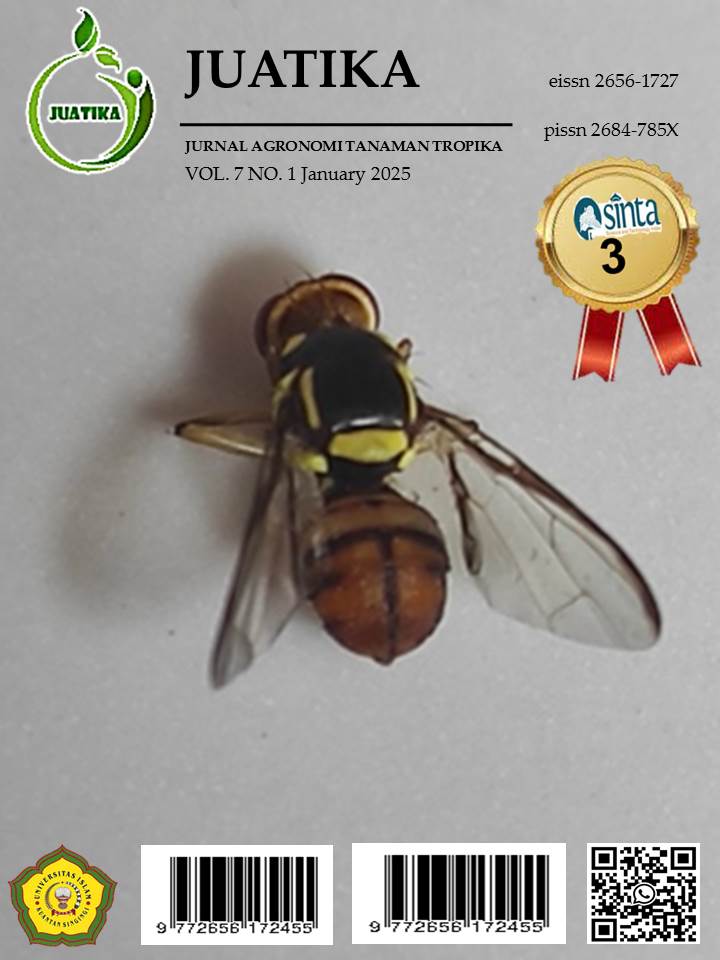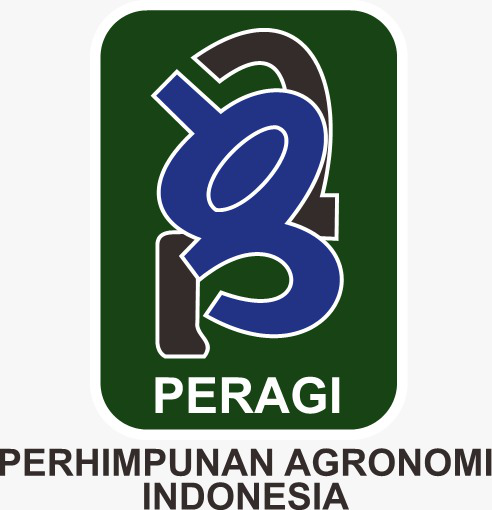Potential of Trenggulun Leaf Essential Oil as an Attractant for Fruit Fly (Bactrocera sp) Pests in Cayyene Pepper (Capsicum frutescens) Plants
Abstract
Fruit flies are the main pests of cayenne pepper. One of the environmentally friendly ways to control is with attractants. The research method used is a Group Randomize Desigen (RGD) factorial pattern with two treatment factors. The first factor is the concentration of trenggulun leaf essential oil which consists of four levels, namely K1=concentration of 0,50 ml, K2=concentration of 0,60 ml, K3=concentration of 0,70 ml, K4=concentration of 0,80 ml. The second factor is the application time (W) which consists of three levels, namely W1= application time every 7 days, W2= application time every 10 days, W3= application time every 14 days. This study aims to determine the most effective concentration and application time. The types of fruit flies trapped are female Bactrocera dorsalis, male Bactrocera dorsalis and female Bactrocera umbrosa. The most effective application time is 10 days with a concentration of 0.80 ml of essential oil. The number of female fruit flies trapped is more than male fruit flies because the content of essential oil compounds of trenggulun leaves contains β ocimen which is an attractant for female fruit flies Bactrocera dorsalis and Bactrocera umbrosa.
Downloads
References
Algifani, F., Adelia, H., & Bangun, L. B. (2021). Efektivitas atraktan dalam mengendalikan lalat buah (Bactrocera sp.) pada tanaman cabai merah (Capsicum annuum). Prosiding Seminar Nasional Lahan Suboptimal. Universitas Sriwijaya Palembang.
Assagaf, S. A. R. (2017). Pengaruh sistem jarak tanam dan pemberian EM-4 terhadap pertumbuhan dan produksi tanaman cabai rawit (Capsicum frutescens). Jurnal Ilmiah Agribisnis dan Perikanan, 10(2), 65–79.
Avianto, Y., Nur, K. S., & Anantia, B. P. (2024). Synergistic effects of photosynthetic bacteria and endophytes: A novel approach to enhance cayenne pepper productivity. JUATIKA, 6(#), 699–711.
Efendy, T. A., Rani, R., & Samad, S. (2010). Pengujian beberapa jenis tanaman sebagai sumber atraktan lalat buah (Bactrocera sp.) (Diptera: Tephritidae) pada tanaman cabai (Capsicum annuum L.). Prosiding Seminar Nasional. Universitas Sriwijaya Palembang.
Salbiah, D., Sutikno, A., & Rangkuti, A. (2013). Uji beberapa minyak atsiri sebagai atraktan lalat buah pada tanaman cabai merah (Capsicum annuum). Prosiding Seminar Nasional. Pekanbaru.
Siwi, S. S., Purnama, H., & Suputa, S. (2006). Taksonomi dan bioekologi lalat buah penting di Indonesia (Diptera: Tephritidae). Australia: Department of Agriculture, Fisheries and Forestry.
Sjam, S., Surapati, S., Rosmana, A., & Thamrin, S. (2011). Teknologi pengendalian hama dalam sistem budidaya sayuran organik. Jurnal Fitomedika, 7(3), 142–144.
Sofiarani, F. N., & Ambarwati, E. (2020). Pertumbuhan dan hasil cabai rawit (Capsicum frutescens) pada berbagai komposisi media tanam dalam skala pot. Jurnal Vegetalika, 9(1), 292–30.
Sukmajaya, A. P. I. G. P., Puspawati, N. M., & Bawa Putra, A. A. (2012). Analisis kandungan minyak atsiri daun trenggulun (Protium javanicum) dengan metode kromatografi gas-spektroskopi massa. Jurnal Kimia, 6(2), 155–162.
Yunandra, M., Elza, Z., & Deviona. (2019). Analisis korelasi dan sidik lintas karakter kuantitatif 20 genotipe cabai (Capsicum annuum). JUATIKA, 1(2), 10–18.
Copyright (c) 2025 Baiq Inggar Linggarweni, Ana Andriana

This work is licensed under a Creative Commons Attribution 4.0 International License.
Authors who publish with Jurnal Agronomi Tanaman Tropika (JUATIKA) agree to the following terms:
Authors retain copyright and grant the Jurnal Agronomi Tanaman Tropika (JUATIKA) right of first publication with the work simultaneously licensed under a Creative Commons Attribution License (CC BY 4.0) that allows others to share (copy and redistribute the material in any medium or format) and adapt (remix, transform, and build upon the material for any purpose, even commercially) with an acknowledgment of the work's authorship and initial publication in Jurnal Agronomi Tanaman Tropika (JUATIKA).
Authors are able to enter into separate, additional contractual arrangements for the non-exclusive distribution of the journal's published version of the work (e.g., post it to an institutional repository or publish it in a book), with an acknowledgment of its initial publication in Jurnal Agronomi Tanaman Tropika (JUATIKA). Authors are permitted and encouraged to post their work online (e.g., in institutional repositories or on their website) prior to and during the submission process, as it can lead to productive exchanges, as well as earlier and greater citation of published work.







 More Information
More Information



